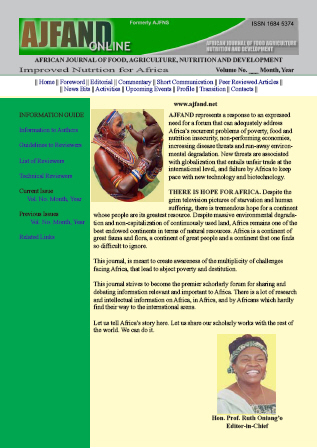
|
African Journal of Food, Agriculture, Nutrition and Development
Rural Outreach Program
ISSN: 1684-5358
EISSN: 1684-5358
Vol. 20, No. 3, 2020, pp. 15857-15875
|
 Bioline Code: nd20042
Bioline Code: nd20042
Full paper language: English
Document type: Research Article
Document available free of charge
|
|
|
African Journal of Food, Agriculture, Nutrition and Development, Vol. 20, No. 3, 2020, pp. 15857-15875
| en |
BIOMASS PRODUCTION AND NUTRITIONAL COMPOSITION OF MORINGA OLEIFERA  UNDER DIFFERENT PLANTING SPACINGS IN A SEMI-ARID CONDITION OF THE NORTHERN SOUTH AFRICA UNDER DIFFERENT PLANTING SPACINGS IN A SEMI-ARID CONDITION OF THE NORTHERN SOUTH AFRICA
Bopape-Mabapa, MP; Ayisi, KK & Mariga, IK
Abstract
Moringa oleifera is an important plant with nutrients concentrated in the leaves. The leaves have high nutritional potential, which can contribute significantly towards human and animal nutrition. Therefore, the tree can feed communities when other foods are typically scarce. This study was conducted to evaluate the effect of planting density on biomass and nutritional composition of Moringa oleifera planted under the semi-arid conditions of the Limpopo Province. The study was conducted at Eiland (NBef Organic Farm) over two consecutive years, 2014–15 and 2015–16. The initial and post-planting physical and chemical properties of the soil at the site were carried out at depths of 0 to 30 and 30 to 60 cm. The experiment was established as a randomized complete block design and replicated eight times. The treatments included planting densities of 5 000, 2 -1 500, 1 667 and 1 250 plants ha-1. Data collection included total dry matter yield, leaf yield (kg ha-1) and leaf nutritional composition. Results from the soil analysis revealed slight acidity and very low nitrogen content (0.08%) at all sampling depths before moringa establishment. In addition, excessive magnesium, manganese and copper contents in the soil were recorded. Soil properties such as phosphorus, potassium, zinc, copper, organic carbon and nitrogen were reduced after the first harvest. During the second harvest, similar soil nutrient reductions followed the same trend as compared to the first harvest except for phosphorus, which showed an increase as compared to initial soil sampling at the second harvest. During harvests 1 and 2, the increase in planting density resulted in increased biomass production. Planting densities also did not affect moringa leaf nutrient composition. The study showed that a population of 5000 plants ha-1 produced the highest biomass yield of more than 1.5 ton ha-1. This study also ha revealed that moringa contains a high level of leaf nutrients even under marginal production conditions, irrespective of the planting density.
Keywords
Biomass production; leaf nutritional composition; moringa; planting population
|
| |
© Copyright 2020 - African Journal of Food, Agriculture, Nutrition and Development
Alternative site location: http://www.ajfand.net/
|
|
